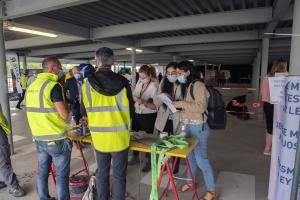Safety comes first
Whether they spend their day in an office at ITER or on one of the upper floors of the Tokamak Complex, driving a vehicle or manoeuvring a crane, every person present on the ITER site is requested to share the same preoccupation: SAFETY.
Safety is a central priority in all ITER activities. As part of a push to require every person across the organization to be actively committed to safety standards, a Safety Day was organized by ITER's Security, Health & Safety Division on 16 September. Through hands-on workshops, dialogue, and demonstrations, the organizers aimed to ensure that everyone who works at ITER, from staff to collaborators, is focused on putting safety first and is well informed about ITER's safety procedures.
"It is never an option to compromise safety," Director-General Bernard Bigot said that morning in an opening speech. "It is always and shall always be the prerequisite for all of our activities on the ITER site."
The Director-General mentioned three main safety risks that would be the object of particular attention at the Safety Day workshops: falling from height, falling objects, and system and process risks.
Chief Scientist Tim Luce also pointed out the invisible dangers of high voltage areas and non-breathable atmospheres. It is essential to read all the signs, follow personal protection equipment rules and always have the means to call emergency services, he stressed. "There are simple things we can all do to stay safe."
Participants from the ITER Organization and all construction entities on site were welcomed at booths organized by companies on the front line of worksite construction activities, including the VFR consortium, Demathieu Bard Construction, Lafont, Diestmann, PMSM, Omega Consortium, GDES, APAVE, Engage, Momentum, Daher, Entrepose, ONET, Vernazza and the machine assembly contractors.
Many of the booths provided visuals and interactive elements to educate on safety issues—quizzing participants on how to safely perform a lift, for example, or using electrical boards to teach about the risks of electricity (shocks and/or electrical fires). And one corner of the exhibition space was dedicated to an escape room game which simulated the safety procedures for leaving the ITER worksite.
But safety is not confined to the worksite—it is part of every department at ITER. Gilles Perrier, Head of the Safety and Quality Department, emphasized that safety also means quality of the work environment, on-time delivery, and taking care with legal and financial issues.
And of course, safety at ITER also involves taking precautions around the evolving COVID-19 situation. ITER continues to maintain high safety standards to protect staff and collaborators during the pandemic, and continues to update COVID-19 resources as needed.
Safety continues to grow in importance as key pieces of the ITER Tokamak are coming together, says Youngeek Jung, Head of the Construction Domain. "We are standing on a major threshold for tokamak construction activities."
Safety procedures will reduce the risk of damaging any of these crucial pieces that represent years of hard work. And, most importantly, these procedures keep everyone safe as these massive components are installed.



